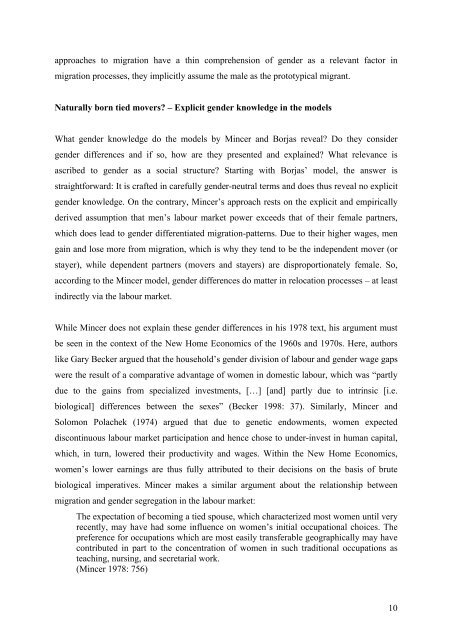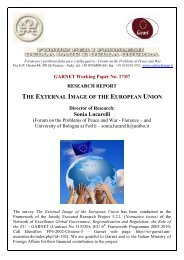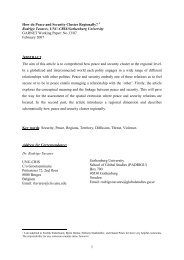1 Gender Knowledge in Economic Migration Theories and in - Garnet
1 Gender Knowledge in Economic Migration Theories and in - Garnet
1 Gender Knowledge in Economic Migration Theories and in - Garnet
You also want an ePaper? Increase the reach of your titles
YUMPU automatically turns print PDFs into web optimized ePapers that Google loves.
approaches to migration have a th<strong>in</strong> comprehension of gender as a relevant factor <strong>in</strong><br />
migration processes, they implicitly assume the male as the prototypical migrant.<br />
Naturally born tied movers? – Explicit gender knowledge <strong>in</strong> the models<br />
What gender knowledge do the models by M<strong>in</strong>cer <strong>and</strong> Borjas reveal? Do they consider<br />
gender differences <strong>and</strong> if so, how are they presented <strong>and</strong> expla<strong>in</strong>ed? What relevance is<br />
ascribed to gender as a social structure? Start<strong>in</strong>g with Borjas’ model, the answer is<br />
straightforward: It is crafted <strong>in</strong> carefully gender-neutral terms <strong>and</strong> does thus reveal no explicit<br />
gender knowledge. On the contrary, M<strong>in</strong>cer’s approach rests on the explicit <strong>and</strong> empirically<br />
derived assumption that men’s labour market power exceeds that of their female partners,<br />
which does lead to gender differentiated migration-patterns. Due to their higher wages, men<br />
ga<strong>in</strong> <strong>and</strong> lose more from migration, which is why they tend to be the <strong>in</strong>dependent mover (or<br />
stayer), while dependent partners (movers <strong>and</strong> stayers) are disproportionately female. So,<br />
accord<strong>in</strong>g to the M<strong>in</strong>cer model, gender differences do matter <strong>in</strong> relocation processes – at least<br />
<strong>in</strong>directly via the labour market.<br />
While M<strong>in</strong>cer does not expla<strong>in</strong> these gender differences <strong>in</strong> his 1978 text, his argument must<br />
be seen <strong>in</strong> the context of the New Home <strong>Economic</strong>s of the 1960s <strong>and</strong> 1970s. Here, authors<br />
like Gary Becker argued that the household’s gender division of labour <strong>and</strong> gender wage gaps<br />
were the result of a comparative advantage of women <strong>in</strong> domestic labour, which was “partly<br />
due to the ga<strong>in</strong>s from specialized <strong>in</strong>vestments, […] [<strong>and</strong>] partly due to <strong>in</strong>tr<strong>in</strong>sic [i.e.<br />
biological] differences between the sexes” (Becker 1998: 37). Similarly, M<strong>in</strong>cer <strong>and</strong><br />
Solomon Polachek (1974) argued that due to genetic endowments, women expected<br />
discont<strong>in</strong>uous labour market participation <strong>and</strong> hence chose to under-<strong>in</strong>vest <strong>in</strong> human capital,<br />
which, <strong>in</strong> turn, lowered their productivity <strong>and</strong> wages. With<strong>in</strong> the New Home <strong>Economic</strong>s,<br />
women’s lower earn<strong>in</strong>gs are thus fully attributed to their decisions on the basis of brute<br />
biological imperatives. M<strong>in</strong>cer makes a similar argument about the relationship between<br />
migration <strong>and</strong> gender segregation <strong>in</strong> the labour market:<br />
The expectation of becom<strong>in</strong>g a tied spouse, which characterized most women until very<br />
recently, may have had some <strong>in</strong>fluence on women’s <strong>in</strong>itial occupational choices. The<br />
preference for occupations which are most easily transferable geographically may have<br />
contributed <strong>in</strong> part to the concentration of women <strong>in</strong> such traditional occupations as<br />
teach<strong>in</strong>g, nurs<strong>in</strong>g, <strong>and</strong> secretarial work.<br />
(M<strong>in</strong>cer 1978: 756)<br />
10





